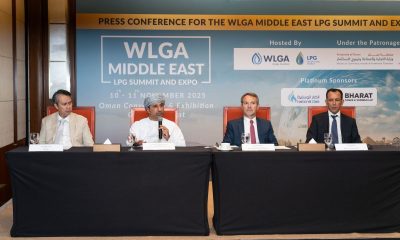Oman 2015
Steady growth
According to a recent Central Bank of Oman report, Oman’s small insurance sector has witnessed a restricted and slow growth but significant upside potential remains to be tapped.

According to a recent Central Bank of Oman report, Oman’s small insurance sector has witnessed a restricted and slow growth but significant upside potential remains to be tapped.
QUICK GLANCE
Gross direct premium of Oman’s insurance firms grew by 9 per cent to RO246.44 million in the first half of 2015.
The average annual growth in insurance sector in the last seven years was 14 per cent.
Total assets of the country’s insurance sector grew by about five per cent to RO827 million last year.
The insurance penetration – the ratio of insurance premiums to gross domestic product (GDP) – was about 1.3 per cent in the country last year.
The Sultanate has 36 insurance brokerage firms and 22 insurance companies.
Insurance industry in the Sultanate has shown a steady growth in the first half of 2015, which was in continuation of the previous year’s achievements. Several players are competing for a bigger share in a relatively small market and the industry is witnessing a healthy growth in recent years. This is despite growth in compensation in the aftermath of recent tropical cyclone damage claims, mainly from construction firms. Gross direct premium of Oman’s insurance firms grew by 9 per cent to RO246.44 million in the first half of 2015, from RO226.89 million for the same period last year. In fact, the Sultanate’s insurance premium surged ahead 10 per cent to RO400.4 million in 2014, from RO364 million in the previous year. Also, the average annual growth in insurance sector in the last seven years was 14 per cent.
Although Oman has a long way to go in terms of total business volume before it can catch up with its GCC counterparts and other developed countries, the country’s low insurance penetration of around one per cent, less even than developing countries like India, is being viewed as a positive factor for the development of medical insurance. According to a recent Central Bank of Oman report, Oman’s small insurance sector has witnessed a restricted and slow growth but significant upside potential remains to be tapped. Total assets of the country’s insurance sector grew by about five per cent to RO827 million last year, which is low given the huge potential available from the relatively under-insured market, the central bank said in the report.
Further, insurance penetration – the ratio of insurance premiums to gross domestic product (GDP) – was about 1.3 per cent in the country last year. It is comparable to that of GCC countries but was much below the global average of 6.5 per cent. Likewise, insurance density, which is per capita insurance premium, is less than RO100 in the country as compared with the GCC average of RO141 and the global average of RO252 per head. The insurance firms need to make concerted efforts to develop the life business in order to diversify their sources of revenues. Health insurance is leading the charge, growing by 32 per cent to RO63.07 million for the first half of this year from RO47.96 million, according to a report released by the insurance market watchdog Capital Market Authority.
Several corporates in Oman tend to provide health insurance for its employees, as well as offer group health insurance among workers for small and medium enterprises. The tendency of companies to make arrangements with designated clinics for providing healthcare facilities is becoming a story of the past, and a group medical coverage is now the norm, rather than the exception. Employee medical insurance is a cashless scheme wherein the insurance company, which ties up with a network of hospitals/polyclinics, gets volume business and the employees get access to cashless healthcare facilities. The market is growing, especially after expatriates moved out of government hospitals to private health centres. More than 10 local companies, including outfits of multinational firms, are currently offering employee group medical insurance to the sultanate’s corporate clients. Other major growth areas were individual life insurance, which grew by 26 per cent, and group life insurance, which surged ahead by 26 per cent, in the first half of 2015. Also, net direct premium increased by 13 per cent RO135.27 million from RO119.33 million during the six month period under review. Maximum growth in net direct premium was witnessed in the case of group life insurance, which surged ahead by 55 per cent, and medical insurance, which soared by 54 per cent. Life group and health insurance achieved the highest ratios in growth in the first half of 2015 increasing by 55 per cent and 54 per cent, respectively, compared to the same period in 2014.
Retention ratios in motor insurance were the highest among different types of insurance, recording 88 per cent for comprehensive insurance and 84 per cent for third party insurance. Also, the retention ratio for individual life insurance was 67 per cent. However, retention ratios for engineering, transport and properties insurance were the lowest compared to other insurance segments as they were 18 per cent, 15 per cent and 9 per cent, respectively, due to reinsurance of largest part of the risk with reinsurers.
The Sultanate has 36 insurance brokerage firms and 22 insurance companies, which are a mix of locally incorporated firms and foreign firms. Of the five largest players, four are listed companies and hold a sizable share of the market. Oman’s insurance sector is adequately capitalised with a capital-to-asset ratio of over 30 per cent. National companies represent the largest portion of the insurance market in the Sultanate. The largest is National Life and General Insurance Company with RO52 million share in direct insurance premium at 21 per cent followed by Dhofar Insurance at 16 per cent, Oman United Insurance at 9 per cent and Al Ahlia Insurance at 8 per cent. An important development, which will have far-reaching results, in recent years, was the amendment to the insurance law. The regulator has raised minimum capital of insurance firms to RO10million (from RO5 million) and asked closely-held national insurance firms to list shares on the Muscat Securities Market within three years. The existing companies have been given a grace period of three years to raise their minimum capital to the new level. Strengthening capital base of insurance firms will make these institutions big enough to underwrite more risks and retain the business within the country, like its peers in other Gulf countries. In fact, the domestic players can get better underwriting capacity, which will enable retaining the business within the country.
The new regulations mark a new chapter in insurance sector in Oman since local companies are able to withstand competition by strengthening their financial, technical and human resources. With the new regulation, as many as eight locally incorporated insurance companies, including a reinsurance firm, will have to offer shares to investing public within three years to comply with the regulation. The national insurance firms that are expected to float shares on the local bourse are Al Ahlia Insurance Company, Muscat Insurance, Muscat Life Insurance, National Life Insurance, Oman & Qatar Insurance, Falcon Insurance and Vision Insurance. Although Falcon has announced its plans for an initial public offering, it was postponed due to the sluggish trend on the market. The insurance watchdog is now focusing on regulating insurance brokers in the country and has already unveiled a draft regulation for insurance firms, which include management of credit facilities between clients and brokerage firms, minimum capital requirements and separation of direct brokerage businesses from re-insurance businesses. The whole idea of the new regulation is to protect the interest of policy holders, besides enhancing the efficiency and role of these intermediaries, who are playing a vital role in the sector.
Of late, several insurance brokerage firms have been fined by Capital Market Authority for delay in submitting financial results and incomplete disclosure of information. Both foreign and local insurance brokerage firms have been either asked to pay fine or given warning for non-compliance of regulations. The market regulator wants to ensure fairness and protection for all participants.
-

 Alamaliktistaad Magazines2 months ago
Alamaliktistaad Magazines2 months agoAlam Al Iktisaad – September 2025 Edition
-

 Magazines2 months ago
Magazines2 months agoOER – September 2025 Issue
-

 News2 months ago
News2 months agoKitchenomiKs Secures Investment of US$3.2M Led by Jasoor Ventures
-

 News2 months ago
News2 months agoOman Inaugurates ‘Hadatha’ – Its All-New Cybersecurity Center
-

 Banking & Finance2 months ago
Banking & Finance2 months agoOman Arab Bank Highlights Its Ongoing Strategic Initiatives and Future Plans
-

 News2 months ago
News2 months agoIEA Expects Global Oil Market to Remain Oversupplied in 2026
-

 Energy2 months ago
Energy2 months agoWLGA Middle East LPG Summit & Expo 2025 to be held at OCEC on November 10 and 11
-

 Real Estate2 months ago
Real Estate2 months agoAl Mouj Muscat Unveils Azura Beach Residences Phase 2: A New Chapter in Waterfront Living































You must be logged in to post a comment Login